Culture stuff...technology series.WOOTZ , UKKU or true damascus steel
One of the noteworthy scientific and technological products of old India was Telangana steel, also called Wootz, Ukku or Damascus steel. It was made in the region around Hyderabad, Andhra Pradesh long ago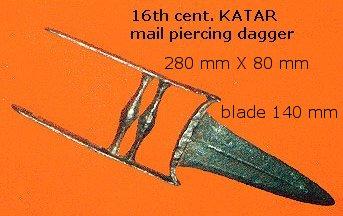 Steel is a modified type of iron mixed with carbon and other elements which give it distinctive properties like hardness, toughness, resistance to rusting etc. The use of iron became fairly widespread after some of the old 'aryan' tribes like hittites developed the technology in the highlands of Iran-Iraq. The related megalithic culture in south India (found all over the drier parts of the plateau) also developed ironmaking skills. They seem to have gone a step further and developed STEEL. This steel making tradition has survived a long time in these parts and became world famous.
Steel is a modified type of iron mixed with carbon and other elements which give it distinctive properties like hardness, toughness, resistance to rusting etc. The use of iron became fairly widespread after some of the old 'aryan' tribes like hittites developed the technology in the highlands of Iran-Iraq. The related megalithic culture in south India (found all over the drier parts of the plateau) also developed ironmaking skills. They seem to have gone a step further and developed STEEL. This steel making tradition has survived a long time in these parts and became world famous.
The fabulous "Damascus steel" was actually steel from Andhra Pradesh and some parts of Karnataka.
Ukku in Telugu and Kannada means steel--this was pronounced by europeans as wootzu and finally wootz. (In telugu, Ukku=steel tukku=rusted iron scrap. Then some dravida language enthusiasts derive it from 'udukku' meaning boiling). It was a hi-tech material of the ancient world. Nothing mysterious or magical or mystical or X-files about it. Just a great deal of intelligent hard work, long observation, trial and error ---- and pounding away at the anvil.
The sword blanks and cakes of ukku wootz were exported in large numbers. Aristotle reportedly commented on its qualities. Some say it dates from around 500 AD. while others say it is far older. But the technology seems to have dwindled and vanished by early 1700's.
Fairly modern looking iron and steel weapons are discovered routinely by archeologists in Andhra for instance during the Kadambapur excavations. The Deccani Kakatiyas (1000-1223 AD) were renowned for their swords and skilled swordsmanship. In south India, ruins of iron smelters with characteristic remains are seen all over Andhra and Karnataka and some parts of Maharashtra and Tamilnadu, in fact wherever iron ore is found. Ukku or wootz steel in particular was transported from Golkonda all over India to centres of excellent sword manufacture in Rajasthan, Bihar, Punjab etc. 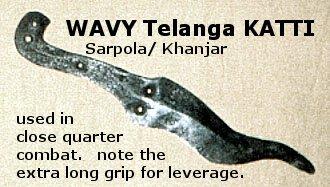 Later, during the Sultan rule, Damascus in today's Syria was a trading and manufacturing center --something like Singapore of today-- and wootz- ukku ingots were imported from the Andhra region. Apart from the ancient Indian swordsmiths, who were probably also the smelters, the artistic swordsmiths and armourers of Syria, Iran, Armenia and Caucusus areas used to beat out the imported semi finished ukku / wootz sword and knife BLANKS into swords and knives and high class armour. These were sold at Damascus.
Later, during the Sultan rule, Damascus in today's Syria was a trading and manufacturing center --something like Singapore of today-- and wootz- ukku ingots were imported from the Andhra region. Apart from the ancient Indian swordsmiths, who were probably also the smelters, the artistic swordsmiths and armourers of Syria, Iran, Armenia and Caucusus areas used to beat out the imported semi finished ukku / wootz sword and knife BLANKS into swords and knives and high class armour. These were sold at Damascus.
Another explanation for the name is derived from the pattern, also called "watered silk" or Damask cloth. (European importers bought Damask cloth at Damsacus.) If two thin silk cloths of plain weave are held close together against a light, characteristic pattern is seen. (technically called moire interference pattern caused by light waves). You decide which is correct, swords sold at damascus or swords displaying the moire pattern.
The crusading europeans got a fright when they encountered Ukku - Damascus swords in action--- a swinging blow with a Damascus sword made of "telingana" steel could cut a man in two even if he was protected with armour. Crusader helmets were of no use against these swords--besides the swords never shattered or broke even with very rough use. What was more, they retained the sharp edge. These stories were persistent, so they are unlikely to be mere legends. More telling, european scientists have been trying since the crusades to reproduce Ukku wootz, with doubtful results.
In arab accounts "hindvi" and "teling" swords are highly valued. In fact the arabs prized it --Prophet Muhammad also had a sword made from this steel, which probably came from somewhere near Hyderabad -Golkonda.
Wootz steel , Ukku gives an idea of the actual, genuine down to earth people's tradition of India, quite at at variance from 'official and high' ones like astrology and religion and linguistics and stuff..
Process of making Ukku or wootz :
The ore contains iron combined with oxygen. These iron oxides (e.g. rust) are burnt with carbon ( e.g. charcoal) which combines with the oxygen and blows away as carbon dioxide gas and leaves behind iron. (technically this process is called reduction). As far as we can gather in Ukku steelmaking, low grade iron ore (in contrast to high grade ores used today in modern steelmaking) was reduced using coal or charcoal fired furnaces: the crude iron billets were reheated with organic matter (more charcoal, twigs and leaves) and some powders again (probably to remove sulphur, phosphorous) to derive steel. The smelters then again heated crude iron/steel ingots in beehive shaped crucibles filled with carbon materials, and ultimately derived a steel called UKKU. ( Ukku is a telugu-kannada word meaning steel and has been modified to "wootz" in europe.) Ruins of such crucibles have been found in Andhra Pradesh near outcrops of iron ore. The local people still have some legends and stories of swords that could cut iron rods with one blow, but no swords or knives of the period are available locally.
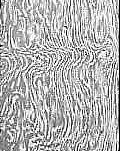 Some accounts say the ukku ingots were refined by hammering when hot to remove impurities. It is said small "beads" of ukku were collected, reheated and hammer-welded together to remove the impurities, improve the grain and make ingots. Then came the "lost" method--these ingots were then further heat treated in some undiscovered ways to form the wootz ingots. These wootz ingots and sword blanks were exported among other places, to Damascus in Syria, Japan and China too. It is a very high carbon steel, similar to the ones used in modern tools, and has a particular arrangement of the combinations of iron and carbon molecules. (e.g. pearlite, cementite -iron carbide). These combinations differ in properties like hardness. On subsequent heat treating the particles (dendrites) arrange themselves in a characteristic pattern which are fully revealed when polished and etched. Basically the smelters were fully aware of the properties of various iron-carbon combinations (eutectic characteristics of iron and carbon alloys) and appear to have known the temperatures and pressures where these changed. (various transition temperatures). Since they didn't have microscopes or sensitive electronic instruments, we presume they used simple trial and error and kept notes ...for several centuries at least, until the sequence was well established. How can we say this? Otherwise the consistency of wootz over so many centuries is hard to explain. The picture shows the characteristic final pattern of some etched damascus blades.
Some accounts say the ukku ingots were refined by hammering when hot to remove impurities. It is said small "beads" of ukku were collected, reheated and hammer-welded together to remove the impurities, improve the grain and make ingots. Then came the "lost" method--these ingots were then further heat treated in some undiscovered ways to form the wootz ingots. These wootz ingots and sword blanks were exported among other places, to Damascus in Syria, Japan and China too. It is a very high carbon steel, similar to the ones used in modern tools, and has a particular arrangement of the combinations of iron and carbon molecules. (e.g. pearlite, cementite -iron carbide). These combinations differ in properties like hardness. On subsequent heat treating the particles (dendrites) arrange themselves in a characteristic pattern which are fully revealed when polished and etched. Basically the smelters were fully aware of the properties of various iron-carbon combinations (eutectic characteristics of iron and carbon alloys) and appear to have known the temperatures and pressures where these changed. (various transition temperatures). Since they didn't have microscopes or sensitive electronic instruments, we presume they used simple trial and error and kept notes ...for several centuries at least, until the sequence was well established. How can we say this? Otherwise the consistency of wootz over so many centuries is hard to explain. The picture shows the characteristic final pattern of some etched damascus blades.
Why isnt ukku made today?
The steel craftsmen and smelters were highly accomplished professionals: but the art is LOST as far as we know -- and the last genuine telingana steel pieces end in the mid 1700's. Note: Not all Indian steel was ukku--while very old Telugu Kannada swords and daggers may be made of wootz, it has to be remembered there were other types of excellent steel also made in India. As far as Ukku-wootz is concerned, apart from swords made in Andhra area, it was used in some high class old Rajput, Mughal, Vijayanagar and early Mahratta swords. But ones made after 1700 seem to be rare.
Probably by that time the art was lost. ( reasons below). The traditional blacksmiths or iron smelters. (called Agaria, semi tribal folk today) do not know anything about Damascus steel.
Other steels going by the name Damascus:
Apart from ukku or true damascus, there are two other types of steel going under the name 'damascus steel'.
PATTERN WELDED STEEL:
 The imitation Damascus ( itself a very high quality steel) is called pattern welded steel. The picture shows a modern example by Raymond Coon, ace bladesmith. it is marked by light and dark thin wavy bands when polished and etched. It is made by repeated folding of strips of steel and hammering them flat to get a laminate. By varying the type of strip (carbon content, nickel etc) and shape, designs can be created: on subsequent forging and grinding the patterns are revealed. Etching brings out the attractive design .
The imitation Damascus ( itself a very high quality steel) is called pattern welded steel. The picture shows a modern example by Raymond Coon, ace bladesmith. it is marked by light and dark thin wavy bands when polished and etched. It is made by repeated folding of strips of steel and hammering them flat to get a laminate. By varying the type of strip (carbon content, nickel etc) and shape, designs can be created: on subsequent forging and grinding the patterns are revealed. Etching brings out the attractive design .
This method called pattern welding has been much attempted ( generally with crude results unless the smith is an expert): some craftsmen have managed to approximate the "damascus look and feel" to get "watered" steel or "silk steel". Obviously, since the process is time consuming and costly , only very expensive things like collectible knives/swords are made today in specialist workshops and blacksmithies. Other materials too like stainless steel are being used today obtain watered pattern steel .
However, while there's a revival of interest in "damascus steel", amateurs and less informed persons do not know the difference between pattern welded steel and true damascus.
(As a curiosity ---most pattern welded strips are very flexible and knives made of pattern welded material can be bent at outrageous angles--even 90 degrees--and will spring back! Good bladesmiths can make a living today too by impressing the customers no end.
Things made of pattern welded steel like well crafted knives and Japanese swords are very beautiful objects of art, besides being quite functional. Pattern welded and twisted strips were used in celtic, viking and roman swords too, usually embedded in the blade for strength and to extend scarce steel.)
Arab 'damascus' There are some reports of another "damascus" made by arab smiths, said to be a crude composite made by immersing hammered iron sheets or strips in bundles, in molten cast iron and quickly fashioning the approximate shape required while still hot. Subsequent grinding achieved the desired final shape. This arab damascus too was pretty good as armour, though useless for swords. Such a steel cannot be reheated and hammered to shape since the cast iron would simply shatter. (I do not think this technique was widely used at all, may have been just a quick fix in times of war.)
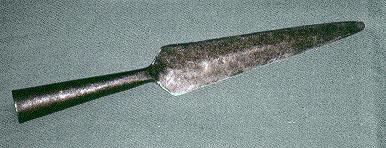 More technical aspects---
More technical aspects---
The original damascus steel or Ukku is totally different.
There is no pattern welding. There may be some folding, but it is one whole piece.
It can be re forged many times without losing its qualities if the smith is skilled and experienced.
The properties of the steel itself are such to give the desired qualities like * STRENGTH
* DUCTILITY WHILE FORGING
* RETAINING AN EDGE
* FLEXIBILITY
* EXTREME TOUGHNESS
These are retained through subsequent treatments, too.
Metallurgists examining pieces of original telingana steel note the internal structure itself is different: while technically it is a ultra-high carbon steel which is very ductile at elevated temperature, very hard yet not brittle at 'normal' temperatures. Old ukku steel is crystalline i.e. without any specific large scale pattern. Some ukku swords have a characteristic watered silk pattern caused by the arrangement of various combinations of iron and carbon in microscopic forms. According to some accounts, this is said to be formed in ukku damascus steel by cooling very slowly from high heat, reheating to slightly less heat and constantly working it. (e.g. Prof. O D Sherby, Stanford).
Another method suggested was heat treating for long periods in reducing conditions, and quenching : next a softer forgeable outer layer is developed. The carbon content of the outer layer is reduced by either grinding (?) or more likely heating in oxidising conditions/ or with iron powder for long periods, cooled, cold forged to shape, polished to mirror finish and edge treated again. In both methods, the pattern is revealed, further amplified by etching with ferric chloride, alum and vegetable dye.
According to Dr.Robert F. Curl (nobel prize chemistry 1996) , in 2006 electron microscopy analysis of ukku specimens revealed a very large number of carbon nanotubes. If so, these smiths were using nanotechnology !
It is also possible the original ukku smiths used some totally different unknown method to obtain the steel. Some smiths have gone further, and developed a characteristic rose-and- ladder design -- basically a series of round dots and parallel lines said to be formed by deeply scoring grooves and punching holes and reforging. But not all genuine ukku swords display this moire pattern --most are just diffusely grained or have a simple overall microscopic swirl pattern of the grains.
Some high quality wootz-ukku swords and knives and armour were further artistically embellished with carvings and inlays of brass, silver, and gold. These are the ones seen in museum collections today, and include swords made specially for important people, for ceremonial functions and the like. However swords in those days were the equivalent of firearms today, hence were basically no frills functional but well made equipment which ensured the wielder returned home after campaigns. So really speaking the old ukku swords and knives and spears were designed for absolutely critical life-or-death scenarios -- battlefield use--- and not for showing off in racks. Such arms are unlikely to be ornately gilted and silver-chased or prettified or pigmented in other ways. (Well, maybe haemoglobin...)
 Why did the art vanish?
Why did the art vanish?
Maybe the steel makers could not compete against mass produced steel. This is possible because wootz steel would be very expensive compared to comparatively modern furnace steel which was developed in spain. As far as the art itself, the detailed techniques may have been lost, in that certain essential steps were NOT told to anybody except their favoured apprentices. Trade guilds i.e. traditional artisan communities in India never reveal full details to outsiders.
There is also a further explanation.
Some scientists like Verhoeven say the special characteristics of the Telangana wootz steel depended on certain trace elements like Vanadium, which may have been present in that particular iron ore body in the locality. When that particular lode was exhausted, the steel made from other ores did not show these characteristics. As the raw material dwindled, the secrets of the master steelmen of Telangana gradually vanished......all we know today is that the process of making Ukku entailed repeated heating and cooling for days on end to red heat at a particular temperature, and hand hammering small globules of steel into ingots, and further treating the lumps into shaped blanks, and then .... some unknown sequence before forging into blanks or swords.
But whatever the secret was it has NOT been found to this day.
No one has really succeded in making 'Telingana' wootz steel, even in the best equipped laboratory. It seems some elaborate and long drawn --and very precise --sequence of heat treatment and other operations was required. 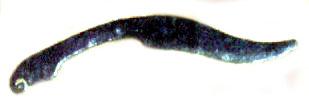 The smiths were absolute masters of their art, and perfectly capable of deducing the conditions required. Someone may have discovered the effect, and long drawn out trial and error could fix the precise process. Steel making in these parts goes back a very long time. Diamond powder for polishing too was available locally.
The smiths were absolute masters of their art, and perfectly capable of deducing the conditions required. Someone may have discovered the effect, and long drawn out trial and error could fix the precise process. Steel making in these parts goes back a very long time. Diamond powder for polishing too was available locally.
There were smelters and furnaces making this steel all over Andhra Pradesh-karnataka active for centuries, especially around Nizamabad district where old Kakatiya furnaces have been found.
Please note: modern metallurgical steels can be precisely made to order to get the exact overall composition of old ukku wootz, but the final results of re creating ukku swords are still not exact. There is no mystical element : the precise methods are lost, that's all. Even today, superplastic steel of the specified desired qualities is still hard to make. A standard process would be a breakthrough, since it means metal parts with complicated shapes and with the desired qualities could be easily made. ( and the process patented...) Modern designer alloys can cut sharper, retain the edge better, etc than ukku but you have to remember the ukku smiths used simple equipment and hand hammered the red hot steel : this goes back many centuries before modern metallurgy. And that's the actual beauty you see, the smiling faces of the ancient smiths in the swirl of Ukku shining at you down the centuries.
updated jan 2008.
Michael Faraday ( unsuccessfully) attempted to make this steel
some Russian researchers last century are said to have approximated the material, they call it bulat.
Research has also been done in IISc Bangalore on damascus steel making by by Sharada Srinivasan at http://www.metalrg.iisc.ernet.in/dept/heritage.html.
Prof J. D. Verhoeven, A.H. Pendray, and W.E. Dauksch
(Iowa State Univ, USA) at http://www.tms.org/pubs/journals/JOM/9809/Verhoeven-9809.html have published the results of experiments to duplicate the damascus fabric by using modern laboratory methods.
II. ESPADAS DE DAMASCO (in spanish, from Mexico) very informative, refers to Dr. Wadsworth and Dr. Sherby's work too.
Don Fogg http://www.dfoggknives.com/damascus.htm --has worked extensively on 'damascus' pattern welded steel
Dr. Jim Hrisoulas -http://www.atar.com has worked a lot on pattern welded steel and written a authoritative book on this
Raymond Coon--http://www.damascusknife.com makes superb modern examples of pattern welded blades
http://damascus.free.fr Very informative site by Georges Emeriau in France. French as well as English
Angelsword.com highlights the work of Master swordsmith Daniel Watson, who has been working for decades on damascus steel
Back to index
© text and pics all rights reserved. by v ramchandra rao | email :vramrao@yahoo
© pic of pattern blade --Raymond Coon
 Steel is a modified type of iron mixed with carbon and other elements which give it distinctive properties like hardness, toughness, resistance to rusting etc. The use of iron became fairly widespread after some of the old 'aryan' tribes like hittites developed the technology in the highlands of Iran-Iraq. The related megalithic culture in south India (found all over the drier parts of the plateau) also developed ironmaking skills. They seem to have gone a step further and developed STEEL. This steel making tradition has survived a long time in these parts and became world famous.
Steel is a modified type of iron mixed with carbon and other elements which give it distinctive properties like hardness, toughness, resistance to rusting etc. The use of iron became fairly widespread after some of the old 'aryan' tribes like hittites developed the technology in the highlands of Iran-Iraq. The related megalithic culture in south India (found all over the drier parts of the plateau) also developed ironmaking skills. They seem to have gone a step further and developed STEEL. This steel making tradition has survived a long time in these parts and became world famous. Later, during the Sultan rule, Damascus in today's Syria was a trading and manufacturing center --something like Singapore of today-- and wootz- ukku ingots were imported from the Andhra region. Apart from the ancient Indian swordsmiths, who were probably also the smelters, the artistic swordsmiths and armourers of Syria, Iran, Armenia and Caucusus areas used to beat out the imported semi finished ukku / wootz sword and knife BLANKS into swords and knives and high class armour. These were sold at Damascus.
Later, during the Sultan rule, Damascus in today's Syria was a trading and manufacturing center --something like Singapore of today-- and wootz- ukku ingots were imported from the Andhra region. Apart from the ancient Indian swordsmiths, who were probably also the smelters, the artistic swordsmiths and armourers of Syria, Iran, Armenia and Caucusus areas used to beat out the imported semi finished ukku / wootz sword and knife BLANKS into swords and knives and high class armour. These were sold at Damascus.
 Some accounts say the ukku ingots were refined by hammering when hot to remove impurities. It is said small "beads" of ukku were collected, reheated and hammer-welded together to remove the impurities, improve the grain and make ingots. Then came the "lost" method--these ingots were then further heat treated in some undiscovered ways to form the wootz ingots. These wootz ingots and sword blanks were exported among other places, to Damascus in Syria, Japan and China too. It is a very high carbon steel, similar to the ones used in modern tools, and has a particular arrangement of the combinations of iron and carbon molecules. (e.g. pearlite, cementite -iron carbide). These combinations differ in properties like hardness. On subsequent heat treating the particles (dendrites) arrange themselves in a characteristic pattern which are fully revealed when polished and etched. Basically the smelters were fully aware of the properties of various iron-carbon combinations (eutectic characteristics of iron and carbon alloys) and appear to have known the temperatures and pressures where these changed. (various transition temperatures). Since they didn't have microscopes or sensitive electronic instruments, we presume they used simple trial and error and kept notes ...for several centuries at least, until the sequence was well established. How can we say this? Otherwise the consistency of wootz over so many centuries is hard to explain. The picture shows the characteristic final pattern of some etched damascus blades.
Some accounts say the ukku ingots were refined by hammering when hot to remove impurities. It is said small "beads" of ukku were collected, reheated and hammer-welded together to remove the impurities, improve the grain and make ingots. Then came the "lost" method--these ingots were then further heat treated in some undiscovered ways to form the wootz ingots. These wootz ingots and sword blanks were exported among other places, to Damascus in Syria, Japan and China too. It is a very high carbon steel, similar to the ones used in modern tools, and has a particular arrangement of the combinations of iron and carbon molecules. (e.g. pearlite, cementite -iron carbide). These combinations differ in properties like hardness. On subsequent heat treating the particles (dendrites) arrange themselves in a characteristic pattern which are fully revealed when polished and etched. Basically the smelters were fully aware of the properties of various iron-carbon combinations (eutectic characteristics of iron and carbon alloys) and appear to have known the temperatures and pressures where these changed. (various transition temperatures). Since they didn't have microscopes or sensitive electronic instruments, we presume they used simple trial and error and kept notes ...for several centuries at least, until the sequence was well established. How can we say this? Otherwise the consistency of wootz over so many centuries is hard to explain. The picture shows the characteristic final pattern of some etched damascus blades.
 The imitation Damascus ( itself a very high quality steel) is called pattern welded steel. The picture shows a modern example by Raymond Coon, ace bladesmith. it is marked by light and dark thin wavy bands when polished and etched. It is made by repeated folding of strips of steel and hammering them flat to get a laminate. By varying the type of strip (carbon content, nickel etc) and shape, designs can be created: on subsequent forging and grinding the patterns are revealed. Etching brings out the attractive design .
The imitation Damascus ( itself a very high quality steel) is called pattern welded steel. The picture shows a modern example by Raymond Coon, ace bladesmith. it is marked by light and dark thin wavy bands when polished and etched. It is made by repeated folding of strips of steel and hammering them flat to get a laminate. By varying the type of strip (carbon content, nickel etc) and shape, designs can be created: on subsequent forging and grinding the patterns are revealed. Etching brings out the attractive design . More technical aspects---
More technical aspects--- Why did the art vanish?
Why did the art vanish? The smiths were absolute masters of their art, and perfectly capable of deducing the conditions required. Someone may have discovered the effect, and long drawn out trial and error could fix the precise process. Steel making in these parts goes back a very long time. Diamond powder for polishing too was available locally.
The smiths were absolute masters of their art, and perfectly capable of deducing the conditions required. Someone may have discovered the effect, and long drawn out trial and error could fix the precise process. Steel making in these parts goes back a very long time. Diamond powder for polishing too was available locally.